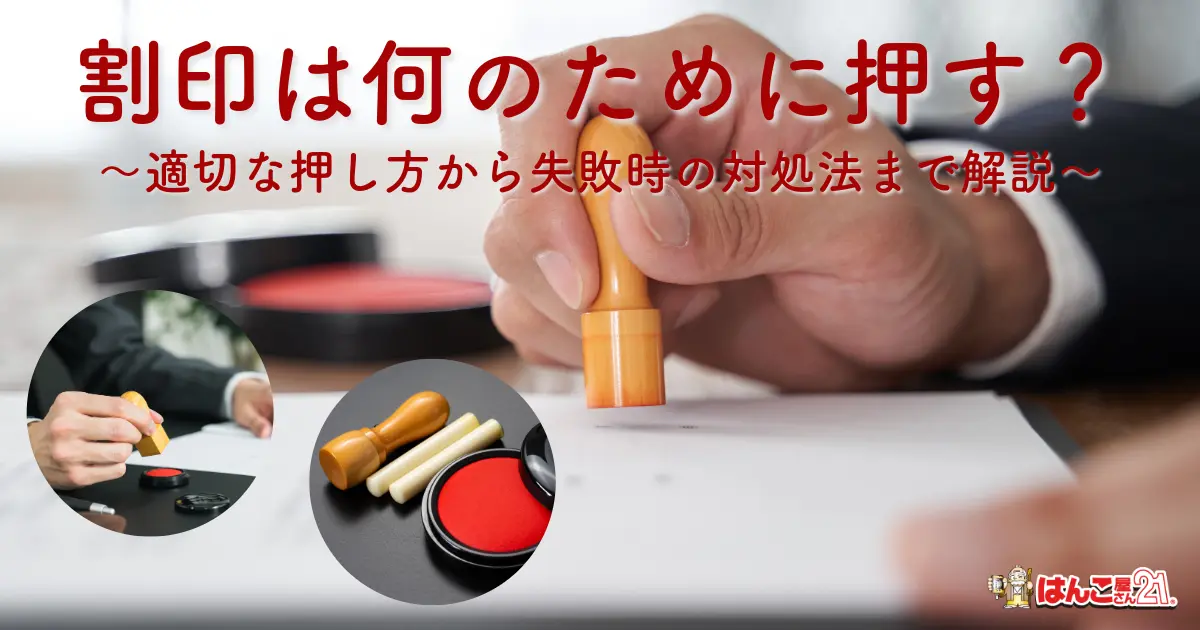Some of you may have heard the term "signature seal" in your daily life. A signature seal is the act of stamping a name written on something or next to a name, and is necessary in situations such as contracts. For this reason, if possible, you should have a seal that can be used for signature seals. However, some people may wonder, "What exactly is a signature seal?" In order to use it appropriately, you should understand what a signature seal is before making a seal. In this article, we will provide a thorough explanation of "signature seals." We will also explain some points to be aware of, so please refer to it.
- What is signing and sealing?
- The meaning of the name seal and the signature seal are the same
- List of words related to name and seal and signature seal
- What is the legal effect of signing and sealing?
- Where should the signature be stamped?
- The type of HANKO used for signing
- Two points to note when signing and stamping a document
- summary
What is signing and sealing?
A signature and seal refers to the act of stamping a seal. There are many different documents that require a signature and seal, including contracts, approval documents, approval slips, purchase orders, and purchase orders.
In addition, signing and stamping a document has the effect of presuming the correctness of the document's creation. Therefore, it is important to properly sign and stamp legal documents such as contracts.
The meaning of the name seal and the signature seal are the same
A similar term to a name seal is a signature seal, but they both have the same meaning. A signature seal is an older term. When using the words differently in practice, a signature seal often refers to a seal.
Also, a signature and seal are used when an individual prepares a document, whereas a name and seal are more likely to be used when a corporation prepares a document.
List of words related to name and seal and signature seal

The main terms related to signing and stamping names are as follows:
- Name and signature
- Signed
- Impression
- Seal/impression
- HANKO and electronic HANKO
- HANKO certificate
We will explain each one in detail.
Name and signature
Inscription refers to the act of writing your name by a method other than handwriting. Printing your name when creating characters using a computer is also considered inscription.
On the other hand , a signature refers to the act of writing one's name by hand. Compared to writing one's name, a signature has stronger probative value as proof that the person created the document.
Signed
A signature refers to the act of the person who created a document signing the document. There are various ways to sign a document, such as signing with a seal, signing with a seal, or signing only.
In particular, the act of creating contracts, treaty documents, etc. is often referred to as signing.
Impression
Impression is the act of leaving an impression on a document. In addition to using a seal, the act of pressing a thumbprint or fingerprint can also be called impression. Also, impression is a somewhat old-fashioned term.
Seal/impression
A seal refers to the stamp itself. Therefore, stamps are often called seals. There are a wide variety of seals, including official seals, bank seals, official title seals, and personal seals.
On the other hand , a seal impression is the mark of red ink that is left when a seal is pressed. The act of leaving an impression on a document is called a seal, stamp, or seal.
HANKO and electronic HANKO
A HANKO is a registered HANKO impression. Although there are cases where the stamp itself is called a HANKO, this is different from the actual meaning. A HANKO impression that is not registered is not a HANKO. Also, a seal that can be used to HANKO is called a jitsuin.
On the other hand , an electronic HANKO is data on a seal impression that can be used to stamp electronic documents such as PDF files and office files. Electronic contracts are now commonplace, and it is not uncommon for companies to use electronic HANKO.
HANKO certificate
A HANKO certificate is a certificate that certifies that a seal registered with a local government or other organization is genuine. Its official name is a HANKO registration certificate.
If you are an individual, you can register HANKO at your local government office. However, if you are going to carry out important legal acts such as starting a company, you must use a registered personal HANKO and submit a HANKO certificate.
When registering a corporation, a seal must be submitted at the Legal Affairs Bureau that has jurisdiction over the place of registration or online. Previously, submitting a seal was required when submitting a registration application online, but as of February 15, 2021, submission of a seal has become optional.
In addition, a HANKO certificate for a registered seal can be obtained by individuals at a local government office, post office, or convenience store, while for corporations, it can be obtained online or at the Legal Affairs Bureau.
What is the legal effect of signing and sealing?
A signature and seal only has the effect of presuming the authenticity of the document on the part on which it is stamped. In other words, anything other than the part on which it is stamped has no effect of presuming the authenticity of the document.
On the other hand, regarding signatures and seals, Article 228, paragraph 4 of the Civil Procedure Act stipulates that "A private document is presumed to be genuine when it is signed or sealed by the person in question or his/her agent." A signature and seal include both a signature and a seal, and in either case, they have the effect of presuming the document's authenticity.
When creating important documents such as contracts, it is appropriate for the creator to sign and seal the document to ensure its validity. Also, when a corporation creates a document, it generally uses a signed seal rather than a signature.
Where should the signature be stamped?
There are no set rules for signing and stamping, and you can stamp wherever you want to a certain extent. However, to prevent stamping in an inappropriate place, it is basic to follow the practical conventions below.
| document | Example of stamp |
| Documents prepared jointly by multiple parties, such as contracts | Create a signature section to write the names of the parties, etc., and then affix a seal to the signature section. |
| Documents created independently, such as purchase orders | Stamp at the end |
| Documents with standard formats, such as documents to be submitted to banks | Stamp according to the format |
If you stamp according to practical practice, you can prevent stamping errors.
The type of HANKO used for signing
The following types of HANKO:
- registered seal
- bank seal
- Personal seal (square seal)
- office seal
- Personal seal
We will explain each one in detail.
registered seal
A registered seal is a personal seal.
For individuals, it is common to be asked to sign and stamp a registered seal when carrying out important legal acts such as real estate transactions. The only characters that can be used are the name as written on the resident's card, and any characters that include an occupation or title are not permitted.
Corporations use seals when concluding contracts to which the corporation is a party. The characters that appear on the seal are mainly the corporation name and job title. Company seals tend to be round in shape, and are sometimes called round seals.
bank seal
A bank seal is a seal that has been registered with a bank.
Documents submitted to a bank must be signed and stamped with a bank seal. For example, when submitting documents to open an account or to change registered information, a signature and stamp with a bank seal are required.
A bank seal is an essential seal for dealings with banks, so if you lose it, you may not be able to withdraw money, apply for credit cards, or issue checks, so be careful.
It is important to be conscious of this on a daily basis, such as storing it in a case and in a designated place.
Personal seal (square seal)
A personal seal is a seal that is not a registered seal or a bank seal. It is used to sign and seal various documents, except for documents related to important legal acts. For example, personal seals tend to be used to sign and seal internal company documents.
In addition, company seals are often square in shape and are also called square seals.
office seal
A position seal is a stamp issued by a company official.
In documents such as approval documents and approval forms, each person in a certain position may need to sign and stamp their own seal. In preparation for such situations, many companies have each person in a certain position have their own official seal.
To prevent the risk of your official seal being used by anyone other than you, it should be carefully managed, such as by carrying it with you at all times or storing it in a locked drawer.
Personal seal
A personal seal is an individual's personal seal.
Regardless of the type, such as a personal seal or a registered seal, if it is personal, it is considered a personal seal. On the other hand, seals used for business purposes, such as official seals, are generally not called personal seals.
Two points to note when signing and stamping a document
When signing your name, please pay attention to the following two points:
- If the contract does not have the seals of the parties, it is impossible to prove that the document is not a forgery.
- Electronic contracts do not require signatures or seals
We will explain each one in detail.
If the contract does not have the seals of the parties, it is impossible to prove that the document is not a forgery.
Article 228, paragraph 4 of the Civil Procedure Act states that if a contract does not bear the seal of the parties, it cannot be proven that the document is not a forgery.
A contract with a seal or signature is considered to have been properly concluded unless there are suspicious circumstances, and is accepted as evidence in court. However, if a contract without a seal or signature is not accepted by the other party, it must be proven that it is not false.
However, even if the contract does not have a signature or seal, the document may be recognized as valid based on other evidence or facts. If the contract between the parties is exchanged via email and transactions are conducted in accordance with the contents of the contract after the date of conclusion, this situation will serve as evidence and the document will likely be recognized as valid.
However, it is true that there is a higher risk of contract disputes when compared to contracts with stamps and signatures. In other words, it is preferable for all parties to stamp and sign contracts when creating them.
Electronic contracts do not require signatures or seals
If it is an electronic contract, there is no need to sign and seal the document, because an electronic signature takes the place of the name and seal.
An electronic signature is a procedure performed on information that can be recorded electromagnetically. The following are recognized as electronic signatures:
- To show that the information was created by the person who executed the electronic signature
- You can check to see if the information has been altered.
With electronic contract services, it is easy to electronically sign contract data. Although it is simple, electronic records with an electronic signature by the person in question are treated as valid. The effect is the same as that of a seal or signature on a paper document.
summary

This time, we introduced the act of signing and stamping. It may seem simple if you think of signing and stamping as the act of pressing a seal, but be careful because there are many similar terms and they can be easily confused.
For example, a name seal and a signature seal are treated as having the same meaning. However, a name seal is more likely to be used when a corporation creates a document, while a signature seal is used when an individual creates a document.
To avoid mistakes caused by confusing words, be sure to understand the meaning of signing and stamping, and be sure to stamp appropriately.
 日本語
日本語 English
English 简体中文
简体中文 繁體中文
繁體中文 한국어
한국어 ไทย
ไทย Tiếng Việt
Tiếng Việt Indonesia
Indonesia Français
Français Español
Español Português
Português


